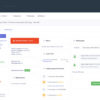
On April 1, a researcher at the Centers for Disease Control emailed Nevada public health counterparts for lab reports on two travelers who had tested positive for the coronavirus. She asked Nevada to send those records via a secure network or a “password protected encrypted file” to protect the travelers’ privacy.
The Nevada response: “Can we just fax them over?”
AP News published an article yesterday describing the absolute train wreck of the data supply chain supporting the COVID-19 response and guiding decision making. While it’s no surprise that many (most) organizations are running on legacy, and badly outdated systems, it’s rare to see the impact of such widespread technology debt exposed the way this pandemic has done.
“You only find out who is swimming naked when the tide goes out.” — Warren Buffett
Well, the tide is out. Right now, data about this pandemic is critical to be accurate and up to date. It turns out that most state and local health departments still rely heavily on faxes, email and spreadsheets. This has seriously impacted the ability to gather and analyze data that peoples’ lives depend on. It’s exposing a symptom of a vast problem faced by most companies, even if the negative consequences aren’t as dire.
“The CDC during this entire pandemic has been two steps behind the disease,” Dr. Ashish Jha
Additionally, the White House has partnered with Palantir, in an effort to build out its data collection platform HHS Protect Now. Vice President Pence asked 4,700 hospitals to provide numbers on test results, patient loads, hospital beds and ICU capacity… daily. This is great in theory but in practice this has utterly overwhelmed already overworked hospital staff with administrative work.
Up to half the lab reports submitted for public health case investigations lack patient addresses or ZIP codes, according to a May 1 Duke University white paper co-authored by Mostashari.
Let’s face it, working to solve this problem while it’s happening is a monumental task. The solution is built of a few components, core of which are modern software systems. The implementation, nationally, is a different story.
The real lesson here is in how this relates to YOUR company.
While your company is likely not using faxes these days (seriously), you are almost certainly relying on emails and spreadsheets as core components of your operations.
Do any of these symptoms hit home?
-
Email and spreadsheet overload
-
Double data entry
-
Lack of real-time dashboards, data and reporting
-
Lack of automation
-
Paper-based systems
Of course they do. For a moment consider the risks:
-
Cost of maintaining old systems
-
Wasted time & effort that could be spent on creative work or new business
-
Compliance or regulatory issues
-
Inability to work remotely
-
Scalability challenges
-
Security risks
Paper based and manual systems are NOT an option any longer. Businesses that don’t agree will be rendered obsolete. Here are a few lessons learned from the story above that you should consider for your business.
-
Legacy systems cost you time and money
-
Collecting data cannot increase the burden on the company
-
Collecting data must be foolproof
-
Data must be standardized and actionable
-
Automation must be applied to maximize efficiency
Don’t swim naked. (In business only).
If you’d like to chat about a technology strategy, systems improvement or software solution I’d love to have a conversation.
















